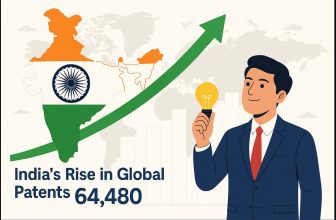Artificial Intelligence is now at the center of economic strategy, global influence, and technological dominance. From generative models to predictive healthcare, countries around the world are investing billions to ensure they don’t fall behind.
But while headlines focus on who’s building the best chatbot or fastest AI chip, the real story lies in long-term investment the money being poured into R&D, infrastructure, startups, and national programs.
This guide breaks down the top 10 countries by cumulative private AI investment up to 2024, shows what these countries are actually doing with that money, and explains where India fits in and what it must do next.
1. Global AI Investment Rankings (2013-2024)
According to the Stanford AI Index 2025 and multiple financial tracking reports, here are the countries that have invested the most private capital into AI over the last decade:
| Rank | Country | Private AI Investment (2013-2024) |
|---|---|---|
| 1 | 🇺🇸 United States | $470.9 billion |
| 2 | 🇨🇳 China | $119.3 billion |
| 3 | 🇬🇧 United Kingdom | $28.2 billion |
| 4 | 🇨🇦 Canada | $15.3 billion |
| 5 | 🇮🇱 Israel | $15.0 billion |
| 6 | 🇩🇪 Germany | $11.3 billion |
| 7 | 🇮🇳 India | $11.1 billion |
| 8 | 🇫🇷 France | $9.0 billion |
| 9 | 🇰🇷 South Korea | $7.3 billion |
| 10 | 🇸🇬 Singapore | $7.3 billion |
The top 3 countries alone account for over 80% of the global private AI investment pie, highlighting a sharp concentration of funding and, by extension, control over global AI capabilities.
2. What Are the Top Countries Actually Building with This Money?
AI investment isn’t just about model training. It covers a broad spectrum of national focus areas and that focus varies sharply between countries.
United States – Global AI Core
- Home to OpenAI, Google DeepMind (US division), Anthropic, Meta AI
- Dominates foundation models (GPT, Gemini, Claude)
- Heavy enterprise integration Salesforce, Microsoft, Amazon, etc.
- Invests in military AI, AI chips (NVIDIA, AMD), and AI in biotech
China – Scaled National AI Infrastructure
- Focus on surveillance, smart cities, manufacturing robotics, and logistics AI
- Major players: Baidu, Huawei, Alibaba DAMO, SenseTime
- Strong government funding and data access but limited global model influence due to censorship
United Kingdom – AI Safety & Research Leadership
- Known for ethical AI, governance, and foundational research (DeepMind’s roots)
- Strong in healthtech and academic AI labs (Oxford, Alan Turing Institute)
- Hosts global AI safety summits
Canada – Research & Open AI Development
- Toronto and Montreal are global AI research hubs
- Produced top researchers behind Transformers and generative AI
- Open-source AI culture (Hugging Face has deep Canadian roots)
Israel – Tactical & Defense-Focused AI
- High investment per capita
- Strong in cybersecurity, edge computing, defense-grade computer vision
- Government + startup integration in AI defense solutions
3. India’s Investment Rank 7th, but Far Behind the Leaders
India’s position 7th globally with $11.1 billion in private AI investment may sound promising. But when viewed in context, the gap is massive:
- U.S. investment is over 40x higher
- Even the UK’s AI funding is 2.5x greater
- China has invested 10x more than India
In terms of annual investment:
- 2023: India secured $1.4 billion, ranked 10th
- 2024: Investment dropped slightly to $1.16 billion, ranked 12th
India is catching up in rank but still far from competing in terms of scale, infrastructure, or global model output.
4. What India Is Building And What’s Still Missing
- Large talent pool: 5 million+ tech professionals; fastest-growing AI upskilling base
- High local demand: AI needed in education, health, agriculture, and local language tech
- Startup energy: India ranks 4th in AI startup count globally
- Government support: The ₹10,371 crore IndiaAI Mission aims to create compute clusters, data sets, and foundational research labs
What India Lacks:
- Large-scale compute: India has limited access to GPU infrastructure and cloud-scale AI training platforms
- Foundational model research: No Indian equivalent of GPT, Claude, or Gemini yet
- Global influence: Indian firms use AI but don’t yet build the tools others depend on
- Public-private scale: Government schemes are underfunded compared to top nations; private capital still cautious beyond mid-stage startups
5. The Real AI Power Gap
| Country | AI Model Development | Compute Infrastructure | Global AI Policy Role | Local AI Use |
|---|---|---|---|---|
| USA | Leader | Leader | Influencer | Strong |
| China | Growing Fast | Expanding Rapidly | Domestic-Only | Strong |
| UK/Canada | Research Driven | Limited | Policy Contributors | Niche |
| India | Limited | Needs Scale-Up | Just Emerging | High Need |
India’s AI investment rank 7th globally reflects growth, but not yet leadership. We’re building tools for our own population. But in the global AI ecosystem, control comes from compute, models, and ecosystems others rely on.
To shift from an adopter to a builder of the global AI future, India must:
- Build national GPU infrastructure
- Fund foundational model development at scale
- Incentivize deep AI research and long-horizon innovation
- Encourage global partnerships beyond backend services





